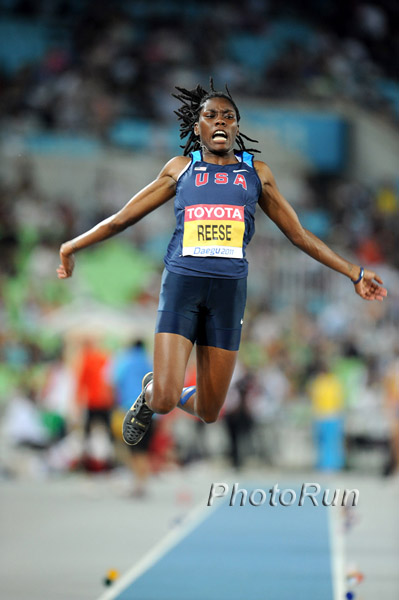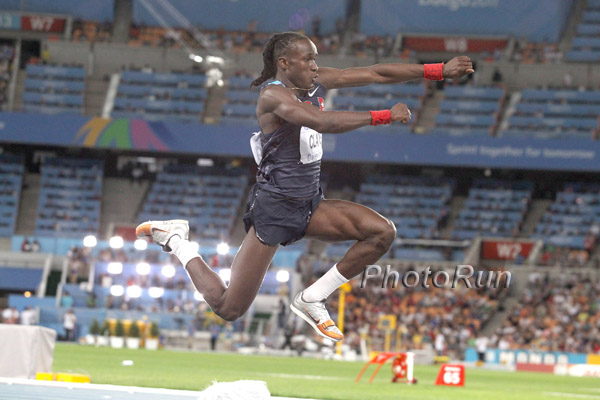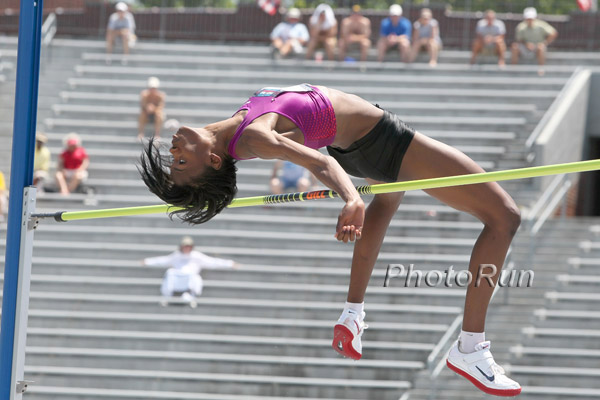
Jesse Williams took gold outdoors at the 2011 World Champs, and Chaunte Howard Lowe surprised, most of all, herself, with her win indoors in the high jump.
The jumps are technical events. A proper warm up is key to your success, as is the cool down. Ask any of the above, and they will tell you that, in the end, the jumps are won by those who are focused, ready and can compete on the big day. Are you ready?
Roy Stevenson wrote this piece for American Track & Field on warming up an cooling down for the jumps. We think you will find it educational.
Warming up and Cooling Down for the Jumps
By Roy Stevenson
RelatedPosts
 Brittney Reese, 2011 WC Long Jump, photo by PhotoRun.net
Brittney Reese, 2011 WC Long Jump, photo by PhotoRun.netBecause of the highly ballistic nature of the jumps, they require a solid warm up before training and competition. Warming up readies the jumper’s muscles by increasing the force of their muscle contractions and speeding up muscle contraction rate, providing that much needed power and speed on the runway. Warming up also helps nervous athletes stabilize their adrenalin rush before competition.
Phase One: Start the warm up with 10-15 minutes jogging to increase body temperature–slow and easy.
Phase Two: Immediately after jogging, jumpers should perform a series of dynamic stretching exercises to reduce muscle stiffness. Although they can start with static stretches, ballistic stretches through a wide range of motion work best because they are closer to the jumper’s actual movements in competition; and research shows that static stretching exercises do not simulate rapid running movement and may actually cause a reduction in leg power.
Phase Three: The jumper progresses to 15-20 minutes of general and jump-specific drills. These drills put the finishing touches on the warm up and prepare the athlete for jump training or competition. Given the requirements for successful jumping (speed, strength, agility), the drills should include a few leg speed exercises that can easily be done with the sprinters.
 Will Claye, 2011 WC Triple Jump, photo by PhotoRun.net
Will Claye, 2011 WC Triple Jump, photo by PhotoRun.net
Typical leg speed warm up drills include series of 5-10 x 50 meter or 5-10 x 100 meter “acceleration stride throughs” where the jumper focuses on correct running technique and staying relaxed while maintaining a fast leg turnover. These should be done with rolling starts, where the jumper gradually picks up his pace after slow jogging for the first 10 meters. Each stride through should be a little faster than the previous one, with the final one being at about 95% of top speed. If your jumpers complain that these accelerations are fatiguing them for the main work out, adjust the number of reps downward, so they will have plenty of energy left for their main workout.
 Jesse Williams, 2011 World Champ, High Jump,
Jesse Williams, 2011 World Champ, High Jump, photo by PhotoRun.net
These drills could also include stationary pop-ups, where the jumper drives off his take-off leg, emphasizing knee lift and a tall body position. These can be over 30-50 meters, but no longer than this. Emphasize proper sprint mechanics and if the jumper is not mastering the drills at fast speeds, try them at a slower speed.
Once the jumpers can handle these fast drills, you might consider giving them a series of general practice drills. Here are a few examples: sideways walking or running (aka carioca), quick foot turnover in ladders, cone running for agility, short high knee lift drills (walking or running), heel kick drills, forward lunge walking, calf walking, plyometrics, calisthenics like squat thrusts, and short uphill sprints, downhill sprints, etc–you get the idea!
 Dwight Phillips, 2011 World Champs, Four gold medals, photo by PhotoRun.net
Dwight Phillips, 2011 World Champs, Four gold medals, photo by PhotoRun.net
It is not necessary to do all of these drills in every warm up–in fact it would be impossible! So just select a few different drills for each warm up to keep it varied, interesting, and fun. The number of repetitions of each of these drills will vary according to how long each drill takes and its complexity. Generally you would expect your jumpers to do 5-10 repetitions of each drill before moving on to the next one.
 Chaunte Howard Lowe, 2010 USA Outdoor, photo by PhotoRun.net
Chaunte Howard Lowe, 2010 USA Outdoor, photo by PhotoRun.net
Phase Four: Jump Specific drills
Follow these drills with several practice run-throughs and jumps. Start with standing long jumps and proceed to short approach drills using a 5,7, or 9-step approach. Skipping, hopping and bounding drills are also excellent for jumpers. Single-leg hops also work well, but make sure you hop on both legs. Bounding drills too, are great. Triple jumpers should do alternate leg bounding. After these drills, the jumper is now ready for the main workout.
Before competition, the jumper should do an abbreviated version of this warm up. Then all he needs to do is walk/jog to keep warm. The pre-competition warm-up needs to be controlled and dampened down so that it does not deplete the jumper’s high-energy phosphates ATP and PC.
Final notes on the warm up.
If the temperature is very cold, a passive warm up, where external heating agents like hot tubs, hot water bottles, and hot showers are applied, can be highly effective, preceding the outdoor warm up.
The cool down
The cool down is an often-neglected part of the workout and every bit as important as the warm up. It consists of an abbreviated warm up. i.e. An easy 5-10 minute jog followed by easy, slow static stretching.
 Janey DeLoach, 2012 US Indoor, Photo by PhotoRun.net
Janey DeLoach, 2012 US Indoor, Photo by PhotoRun.netAuthor

Larry Eder has had a 52-year involvement in the sport of athletics. Larry has experienced the sport as an athlete, coach, magazine publisher, and now, journalist and blogger. His first article, on Don Bowden, America's first sub-4 minute miler, was published in RW in 1983. Larry has published several magazines on athletics, from American Athletics to the U.S. version of Spikes magazine. He currently manages the content and marketing development of the RunningNetwork, The Shoe Addicts, and RunBlogRun. Of RunBlogRun, his daily pilgrimage with the sport, Larry says: "I have to admit, I love traveling to far away meets, writing about the sport I love, and the athletes I respect, for my readers at runblogrun.com, the most of anything I have ever done, except, maybe running itself." Also does some updates for BBC Sports at key events, which he truly enjoys. Theme song: Greg Allman, " I'm no Angel."
View all posts




















